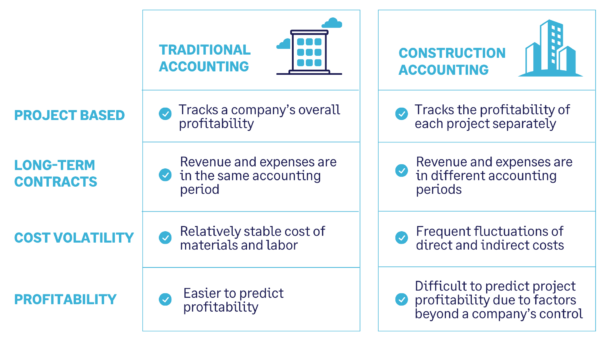A Comprehensive Overview to Building And Construction Bookkeeping: Enhance Your Financial Monitoring
Effective monetary monitoring is critical in the building market, where the intricacies of project-based earnings and expenditures can considerably affect total profitability. An extensive guide to building accountancy supplies beneficial understandings right into work setting you back, budgeting, and expense tracking, customized specifically for the distinct difficulties dealt with by experts in this industry. By utilizing ideal practices in financial coverage and evaluation, stakeholders can not just boost functional effectiveness yet additionally minimize possible threats. Comprehending these concepts is necessary, as they lay the foundation for making educated decisions that can transform financial outcomes. What strategies may be most beneficial for your company?
Comprehending Building Accounting
Comprehending building accountancy is important for the successful monitoring of monetary sources in the building and construction market. This customized branch of accountancy addresses the distinct obstacles dealt with by construction companies, including project-based revenue acknowledgment, cost monitoring, and conformity with regulative demands. Unlike traditional accountancy, construction audit requires an unique approach to handle the complexities connected with lasting contracts and rising and fall costs.
Trick components of building and construction audit include exact revenue recognition, which commonly counts on the percentage-of-completion technique or completed-contract approach, depending on the job's nature. This makes sure that monetary statements reflect real efficiency and profitability in time. In addition, work costing plays an important duty, allowing firms to track costs connected with details tasks, which aids in establishing earnings and source appropriation.
Another essential aspect is the management of capital, which is usually influenced by settlement routines and delays in receivables. Efficient cash flow administration makes certain that building and construction business can satisfy operational needs and purchase future tasks. Inevitably, mastering construction accountancy furnishes firms with the tools required to make enlightened monetary choices, alleviate threats, and enhance total functional effectiveness in an affordable market.

Job Costing and Budgeting
Work costing and budgeting are integral elements of construction audit that make it possible for companies to effectively handle job financial resources and guarantee productivity. Task costing includes the precise tracking of all costs connected with a specific task, including labor, materials, tools, and overhead. This procedure allows construction firms to determine real expense of completing a task, assisting in informed decision-making and enhancing monetary accountability.
Budgeting, on the other hand, works as an economic roadmap for tasks. It entails setting economic restrictions and alloting resources to different task elements, thus developing a framework versus which real prices can be determined. Efficient budgeting requires detailed evaluation and projecting, taking into account historic information, market fads, and prospective dangers.
Together, task setting you back and budgeting provide the necessary tools for building and construction companies to keep an eye on monetary performance, determine variances, and change techniques as required - construction accounting. By applying robust job setting you back techniques and adhering to well-structured budgets, firms can boost their operational efficiency, minimize monetary threats, and eventually improve their earnings in a competitive industry. Thus, these techniques are vital for sustaining long-term success within the building industry
Tracking Costs and Profits
Precisely tracking costs and earnings is essential for building and construction firms to keep financial wellness and make sure job practicality. Effective tracking allows organizations to monitor task efficiency, determine look at these guys price overruns, and make educated economic choices. Applying a methodical technique to videotaping all financial purchases is critical to achieving this objective.
Utilizing building audit software program can significantly improve the monitoring process. These tools facilitate real-time monitoring of expenditures, including labor, products, and subcontractor expenses, while also recording earnings produced from job landmarks and customer repayments. By classifying expenditures and earnings streams, like it firms can get understandings into earnings and capital.

Financial Reporting and Evaluation
Monetary coverage and analysis play a pivotal role in the building and construction market, supplying stakeholders with vital understandings right into a company's economic efficiency and operational performance. Accurate economic records, consisting of equilibrium sheets, revenue statements, and cash money circulation declarations, are essential for assessing the wellness of a building organization. These files aid determine trends, evaluate project productivity, and assist in educated decision-making.
In building and construction audit, economic evaluation goes beyond plain reporting; it entails inspecting financial information to reveal underlying patterns and anomalies. Secret performance signs (KPIs), such as gross profit margins, task completion prices, and return on financial investment, function as benchmarks to determine operational success. On a regular basis examining these metrics enables firms to identify locations calling for renovation, optimize resource allowance, and enhance project monitoring techniques.
Moreover, reliable financial coverage cultivates openness and develops trust with stakeholders, including customers, distributors, and capitalists - construction accounting. By keeping strenuous financial oversight, building business can alleviate threats, ensure compliance with regulatory needs, and ultimately drive lasting growth. Therefore, a robust financial reporting and evaluation structure is vital for navigating the intricacies of the building and construction landscape and attaining long-lasting success
Finest Practices for Success
To accomplish success in construction audit, business must take on a collection of ideal practices that improve operations and improve economic administration. Applying a durable task administration software tailored for building can promote real-time monitoring of task costs and spending plans, enabling for more precise projecting and resource allocation.
Second, embracing a constant technique to work costing is essential. This includes carefully tracking all expenses connected with each task, consisting of labor, products, and overheads. On a regular basis assessing task expenses against initial quotes helps identify variances early, making it possible for prompt restorative activities.
Third, maintaining strenuous documentation methods see page makes certain conformity with laws and simplifies audits. This consists of keeping detailed records of agreements, adjustment orders, invoices, and invoices.
In addition, spending in staff training is crucial. Making certain that workers are fluent in accounting principles, software use, and market standards can considerably boost efficiency and precision in monetary reporting.
Verdict
